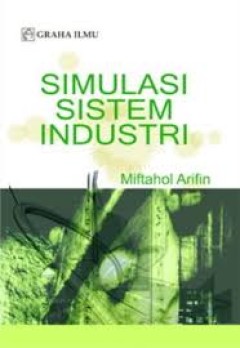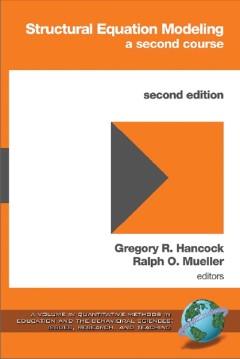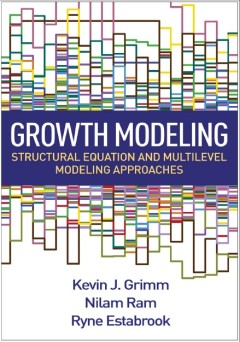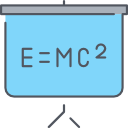Ditapis dengan

Simulasi Sistem Industri
buku ini memberikan pemahaman kepada pembaca mengenai dasar dan konsep model simulasi sebagai alat untuk analisis, pengujian, dan pencarian solusi terhadap masalah-masalah inudstri, mampu melakukan perancangan dn implementasi sistem simulasi dalam suatu kasus industri, serta meganalisis dan menginteprestasikan hasil keluaran program simulasi hasil studi kasus. pembaca diharapakan mampu mengguna…
- Edisi
- Ed. 1 Cet. 1
- ISBN/ISSN
- 978-979-756-455-1
- Deskripsi Fisik
- x, 240 hlm : ill. ; 23 cm.
- Judul Seri
- -
- No. Panggil
- SR 620.0044 MIF s
Principles and Practice of Structural Equation Modeling - Fourth Edition
- Edisi
- Edisi 4
- ISBN/ISSN
- 978-1-4625-2334-4
- Deskripsi Fisik
- xviii + 534 hlm
- Judul Seri
- Methodology in the Social Sciences
- No. Panggil
- EB 519.5 REX p
- Edisi
- Edisi 4
- ISBN/ISSN
- 978-1-4625-2334-4
- Deskripsi Fisik
- xviii + 534 hlm
- Judul Seri
- Methodology in the Social Sciences
- No. Panggil
- EB 519.5 REX p
Structural Equation Modeling
This introductory chapter first sets out the purpose of the book, which is to serve as a concise practical guide for the informed and responsible use of structural equation modeling (SEM). It is designed for social work faculty, researchers, and doctoral students who view themselves more as substantive experts than statistical experts, but who need to use SEM in their research. It is desig…
- Edisi
- -
- ISBN/ISSN
- 9780195367621
- Deskripsi Fisik
- -
- Judul Seri
- -
- No. Panggil
- EB 519.5 NAT s

Meta-Analysis : A Structural Equation Modeling Approach
There were two primary goals for this book. The first one was to present the recent methodological advances on integrating meta-analysis and SEM—the SEM-based meta-analysis (using SEM to conducting meta-analysis) and meta-analytic struc- tural equation modeling (conducting meta-analysis on correlation matrices for the purpose of fitting structural equation models on the pooled correlation…
- Edisi
- -
- ISBN/ISSN
- 9781119993438
- Deskripsi Fisik
- xxi, 369 hlm
- Judul Seri
- -
- No. Panggil
- EB 519.5 MIK m
Structural equation modeling (SEM) : concepts, applications, and misconceptions
Structural equation modeling (SEM) is a general, cross-sectional statistical modeling technique. The chapters in this book propose a Bayesian approach based on SEM; an examination of predictors and outcomes related to school climate using latent class analysis and the testing of specific effects and contrasts in three types of mediation models followed by a discussion on the common types o…
- Edisi
- Edisi 1
- ISBN/ISSN
- 978-1-64382-924-3
- Deskripsi Fisik
- vii, 103 hlm
- Judul Seri
- Mathematics research developments
- No. Panggil
- EB 519.5 LAR s
Growth Curve and Structural Equation Modeling : Topics from the Indian Statis…
- Edisi
- -
- ISBN/ISSN
- 978-3-319-17329-0
- Deskripsi Fisik
- -
- Judul Seri
- Springer Proceedings in Mathematics & Statistics
- No. Panggil
- EB 519.5'3 RAT g
- Edisi
- -
- ISBN/ISSN
- 978-3-319-17329-0
- Deskripsi Fisik
- -
- Judul Seri
- Springer Proceedings in Mathematics & Statistics
- No. Panggil
- EB 519.5'3 RAT g

Structural equation modeling : a second course - 2nd ed.
- Edisi
- Edisi 2
- ISBN/ISSN
- 978-1-62396-246-3
- Deskripsi Fisik
- -
- Judul Seri
- Quantitative methods in education and the behavioral sciences
- No. Panggil
- EB 519.5’3 GRE s
- Edisi
- Edisi 2
- ISBN/ISSN
- 978-1-62396-246-3
- Deskripsi Fisik
- -
- Judul Seri
- Quantitative methods in education and the behavioral sciences
- No. Panggil
- EB 519.5’3 GRE s

Growth modeling : structural equation and multilevel modeling approaches
- Edisi
- -
- ISBN/ISSN
- 9781462526062
- Deskripsi Fisik
- -
- Judul Seri
- Methodology in the social sciences
- No. Panggil
- EB 300.72 KEV g
- Edisi
- -
- ISBN/ISSN
- 9781462526062
- Deskripsi Fisik
- -
- Judul Seri
- Methodology in the social sciences
- No. Panggil
- EB 300.72 KEV g
Using Mplus for Structural Equation Modeling : A Researcher's Guide (Second E…
- Edisi
- 2nd Edition
- ISBN/ISSN
- 978-1-4522-9147-5
- Deskripsi Fisik
- ix, 231 hlm
- Judul Seri
- -
- No. Panggil
- EB 519.5 KEV u
- Edisi
- 2nd Edition
- ISBN/ISSN
- 978-1-4522-9147-5
- Deskripsi Fisik
- ix, 231 hlm
- Judul Seri
- -
- No. Panggil
- EB 519.5 KEV u
A primer on partial least squares structural equation modeling ( PLS-SEM)
academics, industry, government, and individuals are confronted with an explosion of data. The data increasingly are emerging from sources such as web traffic, social networking interactions, search behavior, sensors that track suppliers, customers, and shipments, and GPS systems that monitor traffic, to name only some of the more visible sources. This trend, often referred to as the age o…
- Edisi
- -
- ISBN/ISSN
- 978-1-4522-1744-4
- Deskripsi Fisik
- xv, 293 hlm
- Judul Seri
- -
- No. Panggil
- EB 511 JOS a
 Karya Umum
Karya Umum  Filsafat
Filsafat  Agama
Agama  Ilmu-ilmu Sosial
Ilmu-ilmu Sosial  Bahasa
Bahasa  Ilmu-ilmu Murni
Ilmu-ilmu Murni  Ilmu-ilmu Terapan
Ilmu-ilmu Terapan  Kesenian, Hiburan, dan Olahraga
Kesenian, Hiburan, dan Olahraga  Kesusastraan
Kesusastraan  Geografi dan Sejarah
Geografi dan Sejarah